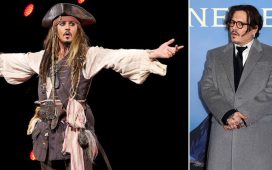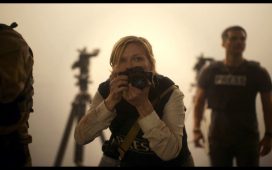In the fall of 2016, the task ahead of Fenton Bailey and Randy Barbato, co-directors of HBO’s Liberty: Mother of Exiles, seemed straightforward, if unclear in the details: delve into the history of the Statue of Liberty, then make a film about the landmark in support of the designer Diane von Furstenberg’s fundraising campaign for its new museum in New York City.
But then Donald Trump was elected that November, vaulting a campaign which began by calling Mexican immigrants “rapists” into the nation’s top office. Soon followed the ban on immigrants from select majority-Muslim countries, and the statue – closely associated with Ellis Island, traditionally the first port of entry for many immigrants to the US – took on a heightened political visibility: America in theory versus America in practice. Protesters have shut down the statue and hung an enormous “Refugees Welcome” banner from its base, and the statue’s likeness has been invoked in countless protest costumes and imagery. An August 2017 press briefing by the Trump adviser Stephen Miller on the White House’s proposal to cut American immigration in half, prioritizing English-speaking immigrants with higher education, devolved into a confrontation with the CNN reporter Jim Acosta over the origins and meaning of The New Colossus, the Emma Lazarus poem accompanying the statue. (Contrary to Miller’s assertion, shown in the film, the poem – “Give me your tired, your poor, your huddled masses” – was written in 1883 to help raise money for the statue’s pedestal on Liberty Island, where it was installed in 1886).
“What we’ve seen in the last three years is not America with its beacon hand of worldwide welcome,” Bailey said. The statue and the poem represent the same intention, he said: “The belief that the wretched refuse is made up of individuals, and that the potential of each and every individual is as great as the most powerful man in the United States.”
No film on the Statue of Liberty in the Trump era could avoid politics, but the directors maintained that they didn’t intend to wade too far into the Trump administration’s political morass. “We didn’t set out to make a political film – politics are so loud and noisy and it’s hard to cut through,” said Barbato. “And so in some ways, that’s why we wanted to make a kind of gentle, inviting film.”
Liberty: Mother of Exiles accounts for the statue’s renewed political potency – the film-makers interview one of the protesters behind the banner, for example – while also opening a door to the statue’s surprising past. They travel to France to visit with descendants of the statue’s parents, the French abolitionist Édouard de Laboulaye, who conceived of the statue as a gift to the post-civil war US, and the sculptor Frédéric Auguste Bartholdi. The sculptor modeled Lady Liberty on another statue he made at the base of the Suez Canal in Egypt, itself based on sketches of an Egyptian Muslim woman. “The possibility that the Statue of Liberty might be based on a Muslim woman – that to me is kind of surprising and somehow beautifully poetic,” said Barbato.
Also poetic is the statue’s oft-forgotten legacy of protest: when the colossal Lady Liberty was unveiled in 1886, women were still 34 years away from the right to vote, and barred from the ceremony; a boat full of suffragists took to New York Harbor demanding recognition. Barbato and Bailey follow this history through to the statue’s global legacy today, capturing slivers of the statue across the world – a factory in China where workers hand-paint liberty figurines, the official liberty souvenir warehouse in Brooklyn, staffed by immigrants from communist Europe. They tail a school trip to the statue from Ellis Prep, a school for recently arrived immigrants, and revisit the damage of Hurricane Sandy in 2012.

One thing that became clear during filming: every person they talked to, from the souvenir store owners to von Furstenberg, was an immigrant or directly descended from an immigrant family. The discovery was “powerful and beautiful, and a reflection of who we are as a nation”, Barbato said. It also underlaid their decision to make von Furstenberg a presence in the film, a stand-in for the viewer as she processes the statue’s past. “The more we looked at it, the more we realized that Diane is in many ways a living embodiment of the statue, even to the chance similarity between the wrap dress [an iconic DVF design] and what the statue is wearing,” said Bailey.
Von Furstenberg, who immigrated from Belgium in the 1970s, inherited an interest in the state from her mother, a Holocaust survivor. “My mother, who was a prisoner, had written me a note saying: ‘God saved me so I could give you life. By giving you life, you gave me my life back – you are my torch of freedom,’’’ von Furstenberg said. “The most surprising thing is that she belongs to everyone,” she said of the filming process. “Everyone takes ownership. She’s like the sun – she warms everybody.”
Barbato and Bailey said they held to that vision of commonality in their filming, making the film’s ultimate subject the vitality of this democratic symbolism. “Taking moment in the midst of the turmoil we’re all immersed in right now to think about the Statue of Liberty, to think about what it represents, this beacon of light and hope – that is important,” said Barbato. “It’s important for us to remember what the Statue of Liberty represents: this idea that we can be great by opening our arms to others.”














